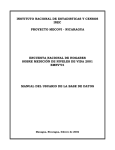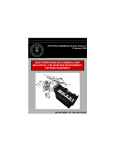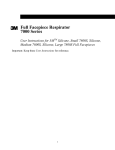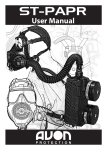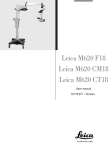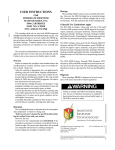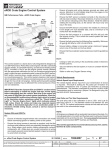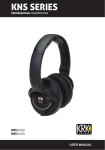Download 3M FR-M40 Owner's Manual
Transcript
FR-M40 Series Full Facepiece Air Purifying Respirator User Instructions for 3M™ FR-M40-10 Full Facepiece Respirator (small), 3M™ FR-M40-20 Full Facepiece Respirator (medium) and 3M™ FR-M40-30 Full Facepiece Respirator (large) (Keep these instructions for reference) 1 GENERAL SAFETY INFORMATION Intended Use The 3M™ FR-M40 Full Facepiece Respirator is designed to help provide respiratory protection against certain airborne contaminants when used in accordance with all use and limitation instructions and applicable safety and health regulations. These User Instructions are not designed to serve as a training manual for personnel with no previous practical experience with air purifying respirators (APR). Contact 3M OH&ESD Technical Service Department for more information on training programs available. For proper use, see supervisor, or instructions, or call 3M Technical Service CAUTION The headstraps of this respirator contain natural rubber latex which may cause an allergic reaction. This respirator helps reduce exposure to certain airborne contaminants but does not eliminate exposure or the risk of contracting disease or infection. Misuse may result in sickness or death. For proper use, see supervisor or User Instructions, or call 3M in U.S.A., 1-800-243-4630. In Canada, call Technical Service at 1-800-267-4414. • • • • • • • • This respirator helps reduce exposure to certain airborne contaminants but does not eliminate exposure or the risk of contracting disease or infection. Misuse may result in sickness or death. For proper use, see your supervisor, product packaging or call 3M in U.S.A. at 1-800-243-4630. In Canada call 3M at 1-800-267-4414. Use only 3M parts with this respirator. Do not use when airborne concentrations of contaminants exceed the maximum use concentration (MUC)of the respirator. See Quantitative and Qualitative Fit Testing section of these User Instructions. This respirator must be inspected before each use to ensure it is in proper operating condition. See Inspection Procedure section. Before you enter a contaminated atmosphere wearing this respirator, you must inspect the respirator, don the respirator according to the instructions provided with the components of the system you are using and complete a User Seal Check. Failure to do so may affect respirator performance and may result in sickness or death. Before removing the respirator, you must leave the contaminated area and be completely decontaminated by following applicable decontamination protocols. Alternatively, have an individual, who has not been contaminated, assist you with doffing. Before storing the respirator, be sure that the respirator has been decontaminated per applicable decontamination protocols. If necessary, dispose of the equipment per applicable waste regulations. Do not connect or use the drinking system in contaminated atmospheres. 2 CAUTION • • • • • Cleaning with solvents may degrade some respirator components and reduce respirator effectiveness. See Maintenance and Cleaning section. Inspect all respirator components before each use to ensure proper operating conditions. The used cartridge must be disposed of in accordance with all applicable waste regulations. Avoid overstretching the holes in the universal second skin. To prevent tearing the exhalation valve cover opening of the universal second skin, be careful pulling it over the flanges of the exhalation valve housing. DS2 is a common agent used in the decontamination of equipment exposed to military chemical warfare agents. DS2 may damage the front and side voicemitters of the mask assembly. When exposed to DS2, rinse voicemitters with clean water. USE INSTRUCTIONS AND LIMITATIONS Important Before use the wearer must read and understand these User Instructions. Keep these instructions for reference. FR-C2A1 is NIOSH approved for chlorine, hydrogen chloride, sulfur dioxide, chloroacetophenone (CN), o-chlorobenzylidene malononitrile (CS) and P100. See 3M™ FR-C2A1 Cartridge User Instructions, Specification section. FR-64 is NIOSH approved for certain organic vapors, sulfur dioxide, chlorine, hydrogen chloride, chlorine dioxide, hydrogen fluoride, ammonia, methylamine, formaldehyde, hydrogen sulfide (escape only), phosphine , chloroacetophenone (CN), o-chlorobenzylidene malononitrile (CS) and as a P100 particulate filter. See 3M™ FR-64 Cartridge User Instructions, Specification section. Note, the FR-C2A1 Cartridge: – Meets canister requirements for protection against CS, CN. – Meets cartridge requirements for chlorine, hydrogen chloride and sulfur dioxide. – Filter meets 42 CFR 84 P100 requirements. – Meets the gas testing criteria of U.S. Military Specification MIL-C-51560(EA) and EA-C-1704. – Is not NIOSH evaluated for any other gases or vapors. Note, the FR-64 Cartridge: - Meets canister requirements for protection against H2S(escape only), Phosphine, CS, and CN. - Meets cartridge requirements for certain organic vapors, sulfur dioxide, chlorine, hydrogen chloride, chlorine dioxide, hydrogen fluoride, ammonia, methylamine and formaldehyde. - Filter meets 42 CFR 84 P100 requirements. - Meets certain gas testing criteria of U.S. Military Specification MIL-C-51560 (EA), EA-DTL=1704A, NATO triptych AC/225 (Panel VII D/103 and QSTAG 1009. Use For 3M recommends the use of this product to help reduce the respiratory exposure of wearers to certain chemical and biological warfare agents when used in accordance with all use and limitation instructions and applicable safety and health regulations. 3 Do Not Use For Atmospheres with less than 19.5% oxygen, concentrations of contaminants which are immediately dangerous to life or health, are unknown or when concentrations exceed the use limitations for the cartridge/filter and facepiece specified in OSHA standards or applicable government regulations, whichever is lower or exposure to industrial chemicals not included in the NIOSH approval. Use Instructions 1. Failure to follow all instructions and limitations on the use of this respirator and/or failure to wear this respirator during all times of exposure can reduce respirator effectiveness and may result in sickness or death. 2. The airborne contaminants which can be dangerous to your health include those that are so small you cannot see them. 3. Before use, the wearer must first be trained by the employer in proper respirator use in accordance with applicable safety and health standards. 4. U.S. Occupational Safety and Health Administration (OSHA) Standard 29 CFR 1910.134 and the Canadian CSA Standard Z94.4 require a written respirator program and also require that the wearer be fit tested before use. 5. Leave contaminated area immediately and contact supervisor if you smell or taste contaminants or if dizziness, irritation, or other distress occurs. Use Limitations 1. Do not use this respirator when the concentration of contaminants is unknown or immediately dangerous to life or health (IDLH). 2. Do not use when concentrations exceed 10 times the permissible exposure limit (PEL) when qualitatively fit tested or 50 times the PEL when quantitatively fit tested, or according to specific OSHA standards or applicable government regulations, whichever is lower. 3. This respirator does not supply oxygen when used in the air-purifying mode. Do not use in atmospheres containing less then 19.5% oxygen. 4. Do not alter, abuse or misuse this respirator. 5. Do not use with beards or other facial hair or other conditions that prevent a good seal between the face and the faceseal of the respirator. NIOSH Cautions and Limitations The following restrictions may apply. See NIOSH approval label. A- Not for use in atmospheres containing less than 19.5 percent oxygen. B- Not for use in atmospheres immediately dangerous to life or health. C- Do not exceed maximum use concentrations established by regulatory standards. H- Follow established cartridge and canister change schedules or observe ESLI to ensure that cartridges and canisters are replaced before breakthrough occurs. J- Failure to properly use and maintain this product could result in injury or death. L- Follow the manufacturer’s User’s Instructions for changing cartridges, canister and/or filters. M- All approved respirators shall be selected, fitted, used, and maintained in accordance with MSHA, OSHA, and other applicable regulations. N- Never substitute, modify, add, or omit parts. Use only exact replacement parts in the configuration as specified by the manufacturer. O- Refer to User’s Instructions, and/or maintenance manuals for information on use and maintenance of these respirators. P - NIOSH does not evaluate respirators as surgical masks. S- Special or critical User’s Instructions and/or specific use limitations apply. Refer to User’s Instructions before donning. 4 S-Special or Critical Use Instructions There is no NIOSH approval schedule for chemical or biological warfare agents; only the tear agents CN & CS. Use of this respirator along with the FR-C2A1 or FR-64 cartridge helps reduce wearer exposure to certain chemical and biological warfare agents when used in accordance with all use instructions and applicable safety and health regulations but does not eliminate exposure or the risk of contracting disease or infection. Time Use Limitations 1. If respirator or cartridge becomes damaged, soiled, or breathing becomes difficult, leave the contaminated area immediately and repair or replace the respirator or cartridge. 2. Replace filters in accordance with the filter Time Use Limitations. (See filter User Instructions.) 3. Replace cartridges in accordance with an established change schedule or earlier if smell, taste or irritation from contaminants is detected. General Description The NIOSH approved 3MTM FR-M40 system is a negative pressure air purifying respirator (APR). The facepiece attaches to the head by a series of six straps that are pulled tight to seal the facepiece around the face and help minimize air leakage. The facepiece exhalation valve opens when air is exhaled, and prevents external air from entering during inhalation. Before use, the wearer must be trained by the employer in the proper donning, operation, inspection, emergency procedures and maintenance of the APR. Training must be in accordance with and include these User Instructions. Improper use may result in serious bodily injury or death. PRODUCTS, ACCESSORIES AND PARTS 3M™ Full Facepieces (Figures 1 and 2) fig. 1 fig. 2 Product Name FR-M40-10 FR-M40-20 FR-M40-30 Full Facepiece, Small Full Facepiece, Medium Full Facepiece, Large Facepiece Material: Facepiece Color: Facepiece Lens Material: Head Harness: Head Harness Color: Unit Weight (approx.): Silicone Rubber Olive Drab Hardcoated Polycarbonate Elastic/Fabric Black Elastic with Olive Drab Head Pad 19.7 oz. (.56 kg) 5 3M™ Spare Parts (Figures 3-6) fig. 3 fig. 4 fig. 5 fig. 6 Product Number FR-M40-101 FR-M40-102 FR-M40-103 FR-M40-104 6889 FR-M40-106 FR-M40-107 (a) (b) (c) (d) (e) (f) (g) FR-M40-108 FR-M40-109 (h) (i) Product Name Head Harness Inhalation (Inlet) Valve Kit (includes valve disk and valve body) Nose Cup Valve Disk (2) Exhalation (Outlet) Valve Cover Exhalation (Outlet) Valve Disk Internal Drink Tube Side Voicemitter Kit (includes voicemitter, gasket, retainer and removal tool) D-ring Side Voicemitter Removal Tool (not pictured) External Drink Tube Quick Disconnect Coupling 3M™ Accessories (Figures 16-23) fig. 16 fig. 17 fig. 18 6 fig. 19 fig. 22 Product Number FR-M40-1 (fig. 16) FR-M40-2 (fig. 16) FR-M40-3 (fig. 18) FR-M40-4 (fig. 20) FR-M40-5 (fig. 22) FR-M40-6 (fig. 22) fig. 20 fig. 21 fig. 23 Product Name Weight Eyepiece Outsert, Clear (2) 4.2 oz. (0.12 kg) Eyepiece Outsert, Gray (2) 4.2 oz. (0.12 kg) Quick Doff Hood (Butyl Rubber Coated Fabric, Olive Drab) 8.5 oz. (0.24 kg) Spectacle Kit 0.7 oz. (0.02 kg) Universal Second Skin, Butyl Rubber, (Black) S 3.9 oz. (0.11 kg) Universal Second Skin, Butyl Rubber, (Black) M/L 3.9 oz. (0.11 kg) CAUTION Used cartridge must be disposed of in accordance with all applicable regulations. 7 3M™ Combination Cartridge/Filters fig. 7a Product Number FR-C2A1 (fig. 7a) FR-64 (fig. 7b) fig. 7b Product Name Cartridge, Aluminum, Olive Drab FR-64 Cartridge, Plastic, Black Weight 9.2 oz. (0.26 kg) 12.0 oz. (0.34 kg) PRINCIPLES OF OPERATION Cartridge Selection For assistance with 3M cartridges, call 3M OH&ESD Technical Service. Before using any of the products, the user must read the specific use limitations and warning information on the cartridge packaging. For NIOSH approval numbers, please see approval label. The FR-C2A1 and FR-64 cartridges are approved as an assembly when used with the 3M FR-M40 facepiece. Service Life of Chemical Cartridges and Filters The useful service life of chemical cartridges will depend upon the activity of the wearer (breathing rate), the specific type, volatility and concentration of the contaminants and environmental conditions such as humidity and temperature. The integrity of the respirator should be checked and the cartridges replaced according to the cartridge change schedule or as soon as the wearer begins to smell or taste the contaminant(s) or irritation occurs. Do not use when airborne concentrations of contaminants exceed the maximum use concentration (MUC) of the respirator. See fit testing section of these User Instructions. If respirator becomes damaged or breathing becomes difficult, leave the contaminated area immediately and repair or replace the respirator. When used for non-particulates (eg. hazardous vapors or gases) a change out schedule regarding the contaminants of interest, for the cartridge, must be established. Dispose of cartridge after initial use in accordance with applicable regulations. 8 INSTRUCTIONS FOR ASSEMBLY AND FITTING For further information concerning assembly and fitting, call 3M OH&ESD Technical Service Cartridge (Figure 8) fig. 8 1. Screw the cartridge into the facepiece inhalation port. This port is found on the right hand side, as you are looking at the front of the facepiece. 2. When the cartridge first contacts the inlet port gasket, tighten the cartridge up to an extra 1/4 turn to insure a tight, leak free seal. Left/Right Cartridge Conversion (Figures 9-11) fig.9 fig. 10 fig. 11 1. Remove cartridge from the facepiece by unscrewing counter clockwise. 2. Grasp the inhalation valve body seat at the two tabs that stick out away from the facepiece, and pull straight away until it is unseated from the side port. CAUTION Do not pull on the spokes of the inhalation valve body seat as this may break the spokes and require replacement of the inhalation valve kit 3. Set aside the inhalation valve assembly on a clean surface for later installation. 9 4. Remove the side voicemitter retainer by unscrewing counter clockwise using the D-ring voicemitter removal tool or a standard 1 3/16 x1 inch D-ring or similar tool. 5. Remove the side voicemitter from the mask assembly by pressing from the inside of the mask assembly. Remove the gasket from the sideport housing on the mask exterior. 6. Insert the inhalation valve body seat into the opposite sideport, with the inhalation valve facing IN, at a slight angle into the sideport of the facepiece. 7. After initially catching a portion of this groove on the metal flange, press the valve body seat down (all around the circumference) into the facepiece sideport until the valve body seat is fully seated in the sideport. 8. To verify that the valve body seat has been properly re-installed, grasp the two tabs sticking straight up from the valve body seat and try to turn the entire valve body seat in the port. If it turns freely, the valve body seat has been correctly re-installed. 9. Position the gasket in the sideport opposite the inhalation valve kit. 10. Install the side voicemitter with the four beaded side facing out. 11. Position side voicemitter retainer in the sideport. 12. Tighten the voicemitter retainer by turning clockwise with the D-ring voicemitter removal tool or a standard 1 3/16 x1 inch D-ring or similar tool. 13. Install the cartridge, now on the opposite side, by turning clockwise. INSPECTION PROCEDURE This respirator must be inspected before each use to ensure it is in good operating condition. Any damaged or defective parts must be replaced before use. Failure to do so may affect respirator performance and may result in sickness or death. 1. 2. 3. 4. 5. 6. 7. Check the faceseal for cracks, tears and dirt. Examine the inhalation valve for signs of distortion, cracking or tearing. Check that the head straps are intact and have good elasticity. Examine all plastic parts and gaskets for signs of cracking or fatiguing and replace if necessary. Remove the exhalation valve cover by grasping the tab at the bottom of the exhalation valve cover and lifting. Examine the exhalation valve and seat for signs of dirt, distortion, cracks or tears. Do not use tissue paper or a paper towel to remove dirt or moisture from exhalation valve cover, exhalation valve or valve seat. Paper may leave behind particles, which may lodge in the valve seat and prevent proper operation (the valve will leak). A cheese cloth may be used for cleaning. Replace the valve if necessary. Secure the exhalation valve cover prior to use. Examine the lenses for signs of cracking or other damage. Check to see that the front and side voicemitters are functioning properly. If speech is fairly clear, they are functioning. Check to see that the internal and external drinking tubes are functioning properly. This can be done by dipping the external drink tube quick disconnect into a cup of water and blowing. If no bubbles are seen, the drinking system is functioning properly. If bubbles are seen, repair or replace the facepiece. 10 Before you enter a contaminated atmosphere wearing this respirator, you must inspect the respirator, don the respirator according to the instructions provided with the components of the system you are using and complete a User Seal Check. Failure to do so may affect respirator performance and may result in sickness or death. FITTING INSTRUCTIONS Must be followed each time respirator is worn. Donning and User Seal Check (Figure 12) fig. 12 1. Fully loosen all six head straps and invert the head harness over the front of the facepiece. 2. Place your chin in the chin cup of the facepiece and press the mask assembly snugly against your face. 3. Grasp the tab at the bottom of the head harness and pull the head harness over your head. Be sure that your ears are between the temple straps and the bottom straps. 4. While holding a hand firmly on the facepiece and keeping the headpad centered on the back of the head, use your other hand to tighten the bottom straps one at a time, insuring that the straps lay flat against your head. 5. Tighten the temple straps until they are snug. Insure that straps lay flat against the head. 6. Tighten the head straps until they are snug and eyes are looking through the top 1/3 of the eyepieces. Insure that straps lay flat against the head. 7. Perform a positive or negative pressure user seal check each time that the respirator is donned. Note: The negative pressure seal check is recommended. 11 Positive and Negative Pressure User Seal Checks Positive Pressure Seal Check (Figure 13) fig. 13 Close off the exhalation valve by pushing firmly on the center of the exhalation valve cover with the heal of one hand. It may be difficult to close the exhalation valve completely, therefore you must blow out or exhale hard. If the facepiece bulges slightly and no air leaks between the face and facepiece are detected, a proper seal has been obtained. If air leakage is detected around the faceseal, reposition the respirator on the face and/or readjust the tension of the straps to eliminate leakage and perform another user seal check. If you cannot achieve a proper fit, do not enter the contaminated area. See your supervisor. Negative Pressure Seal Check (Figure 14) fig. 14 The negative pressure seal check is the recommended user seal check method for this respirator. With the palm of your hand, cover the inlet port on the outside of the cartridge. Inhale gently. If the facepiece collapses slightly, and no air leaks between the face and facepiece are detected, a proper fit has been obtained. If air leakage is detected, reposition the respirator on the face and/or readjust the tension of the straps to eliminate leakage and perform another user seal check. If you cannot achieve a proper fit, do not enter the contaminated area. See your supervisor. Quantitative and Qualitative Fit Testing The effectiveness of a respirator will be reduced if it is not fitted properly. Therefore, either quantitative or qualitative fit testing must be conducted prior to the respirator being issued and used. Note: Fit testing is both a U.S. Occupational Safety and Health Administration (OSHA) and Canadian requirement. 12 Quantitative Fit Testing (QNFT) can be conducted with 42 CFR 84 P100 type filters. To conduct QNFT on the FR-M40 facepiece, screw a 701 Filter Adapter into the filter inhalation port in the facepiece. Next, attach a 601 Quantitative Fit Test Adapter along with a 3M 2000 Series P100 42 CFR 84 approved filter. If quantitative fit testing (QNFT) is utilized, a fit factor (FF) of at least 500 must be obtained. The respirator may be used up to an assigned protection factor (APF) of 50 times the allowable exposure limit. Qualitative Fit Testing (QLFT) can be conducted with the cartridge in place. The 3M FT-10 (sweet) or FT-30 (bitter) Qualitative Fit Test Apparatus can be utilized to conduct the fit testing. If qualitative fit testing (QLFT) is utilized, a passing fit factor (FF) of at least 100 is assumed. The respirator may be used up to an assigned protection factor (APF) of 10 times the allowable exposure limit. Doffing the Respirator (Figure 15) fig. 15 Before removing the respirator, you must leave the contaminated area and be completely decontaminated by following applicable decontamination protocols. Alternatively, have an individual, who has not been contaminated, assist you with doffing. Before storing the respirator, be sure that the respirator has been decontaminated per applicable decontamination protocols. If necessary, dispose of the equipment per applicable waste regulations. 1. 2. Loosen the bottom straps of the facepiece. If this respirator is assigned to an individual user, do not loosen the temple or head straps. Note: This will allow for quicker donning in the future as the temple and head straps will already be adjusted for the individual user. Only the bottom straps will require major adjustment after the respirator is donned. Temple and head straps may require only minor readjustment. 3. Place one hand on the front voicemitter to hold the facepiece on the face. With the other hand grasp the head harness tab and pull the head harness over the front of the facepiece. 13 MAINTENANCE AND CLEANING CAUTION Cleaning with solvents may degrade some respirator components and reduce respirator effectiveness. Inspect all respirator components before each use to ensure proper operating conditions. 1. Remove cartridge, outserts and quick doff hood (if applicable). Set cartridge aside, away from cleaning operations. 2. Remove exhalation valve cover. 3. Remove universal second skin (if applicable). 4. If necessary, remove greasy or oily substances from your mask assembly, universal second skin, quick doff hood and outserts, inside and out with household rubbing (isopropyl) alcohol. 5. Clean the facepiece (excluding cartridge), universal second skin and quick doff hood by immersing in warm soapy water and scrub with a soft brush until clean. Parts may also be cleaned in a washer. Note: Water temperatures should not exceed 120° F (49° C). Do not use cleaning agents that contain lanolin or other oils. 6. Disinfect respirator by soaking in a solution of quaternary ammonium disinfectant or sodium hypochlorite [1oz (30ml) household bleach in 2 gallons (7.5L) of water], or other disinfectant. 7. Rinse in fresh, warm water and air dry in non-contaminated atmospheres or wipe dry with a cheesecloth. Do not use tissue paper or a paper towel. Paper may leave behind particles, which may lodge in the valve seat and prevent proper operation (the valve will leak). Drying temperatures must not exceed 120° F (49° C). CAUTION DS2 is a common agent used in the decontamination of equipment exposed to chemical military agents. DS2 may damage the voicemitters of the mask assembly. When exposed to DS2, rinse voicemitters as soon as possible with clean water. OPTIONAL ACCESSORIES Respirator parts should be inspected prior to each use. Replace worn or deteriorated parts with new parts. 3M™ FR-M40-1 Eyepiece Outserts, Clear (Figures 16 and 17) 3M™ FR-M40-2 Eyepiece Outserts, Gray (Figures 16 and 17) fig. 16 fig. 17 14 1. The outserts can be attached to the facepiece by first rolling the rubber ring up all around the edge of the outsert. 2. Position the outsert over the appropriate eye ring and roll rubber ring down all around the eye ring. 3. Repeat for both outserts. To remove, reverse the steps. 3M™ FR-M40-3 Quick Doff Hood (Figures 18 and 19) fig. 18 fig. 19 1. Universal second skin must first be in place on the facepiece (see FR-M40-5). 2. Lay Quick Doff Hood (QDH) flat on a non-abrasive surface with the hole up and the short hood clips (representing the front the hood) on top and nearest to you. 3. Insert the facepiece face up through the bottom of the QDH. 4. Stretch the elastic opening of the QDH over and around the eyepieces, voicemitter, inhalation port and exhalation valve cover. 5. The QDH elastic must not interfere with any of the items listed above and should be located between the exhalation valve disk cover and the retaining ridge at the chin of the Universal Second Skin. 3M™ FR-M40-4 Spectacle Kit (Figures 20 and 21) fig. 20 1. 2. 3. 4. fig. 21 Lay the facepiece face down on a non-abrasive surface. Hold the spectacle kit with the spring nose bridge piece facing downward (away from you). Insert the side brackets into the pockets formed by the eye lenses and the facepiece. Repeat for other lens. 15 3M™FR-M40-5 Universal Second Skin, S 3M™ FR-M40-6 Universal Second Skin, M/L (Figures 22 and 23) fig. 22 fig. 23 1. Remove cartridge from facepiece (if applicable). 2. Remove the exhalation valve cover from the facepiece (FR-M40-104). 3. Orient the universal second skin with the quick doff hood retaining ridge facing outward (toward you) and at chin area. 4. Feed the external drinking tube through the exhalation valve body opening in the universal second skin. 5. Stretch exhalation valve body opening of the universal second skin, and position it over the exhalation valve body housing of the mask assembly. CAUTION Avoid overstretching the holes in the universal second skin. To prevent tearing the exhalation valve cover opening of the universal second skin, be careful pulling over flanges of the exhalation valve housing. Note: There are two side openings on the universal second skin. One fits over the side voicemitter. The other fits over the side port where the cartridge is attached. Stretch side voicemitter opening of the universal second skin over the side voicemitter of the mask assembly. Stretch the other opening of the universal second skin over the side port of the mask assembly. 6. Stretch the front voicemitter opening of the second skin and position it over the front voicemitter of the mask assembly. 7. Stretch eyelens openings of the universal second skin and position over the eyelenses of the mask assembly. 8. Reinstall exhalation valve cover. 9. Install eyepiece outserts (clear or gray), if applicable. 10. Reinstall cartridge. 16 Spare Parts 3M™ FR-M40-101 Head Harness (Figures 24 and 25) fig. 24 fig. 25 1. Lengthen head harness to its full extent and then work tabs at the ends of the head harness straps out of buckles. 2. To install a new head harness, lay mask face down on a non-abrasive surface with the exhalation valve closest to you. 3. Position harness in mask assembly with backpad harness tab pointing toward you and harness cross strap on top of upper head straps. 4. Work head harness straps into buckles by pushing through lower part of slide then folding over onto itself and pushing back through upper part of slide. 5. Pull straps through approximately 1 inch (2.5 cm) so that head harness straps ends are laying on the outside. 6. Stretch head harness away from mask assembly and check that the buckles hold head harness straps tightly. 3M™ FR-M40-102 Inhalation Valve Kit (Figure 26) fig. 26 1. Remove cartridge from the facepiece. 2. Grasp the inhalation valve body at the two tabs that stick out away from the facepiece, and pull straight away. 3. Discard damaged valve disk and seat assembly. 4. To install a new inhalation valve kit, insert the inhalation valve seat body, with the inhalation valve facing in, at a slight angle into the side port of the facepiece. 5. After initially catching a portion of this groove on the metal flange, press the valve seat body down all around the circumference into the facepiece side port until the valve seat body is fully seated in the side port. 17 6. To verify that the valve seat body has been properly re-installed, grasp the two little tabs sticking straight up from the valve seat body and try to turn the entire valve seat body in the port. If it turns freely, the valve seat body has been correctly re-installed. 3M™ FR-M40-103 Nose Cup Valve Disk (Figures 27 and 28) fig. 27 fig. 28 1. 2. 3. 4. Invert head harness over front of mask assembly. Curl back lip of nose cup toward lens to expose nose cup valve seat and valve disk. Pull nose cup valve disk out of each nose cup valve seat from inside of nose cup. To install new nose cup valve disk, press nose cup valve disk onto nose cup valve seat from inside until nose cup valve disk is flat against nose cup valve seat and the stem slips completely through the hole in the nose cup valve seat. A slight pull on the valve stem may help set it correctly. 5. Gently rotate the nose cup valve disk to make sure that it is completely seated. 6. Repeat steps 2-5 to install the remaining nose cup valve disk. 7. Return head harness to its original position. 3M™ FR-M40-104 Exhalation Valve Cover (Figure 29) fig. 29 1. Pull quick disconnect coupling from the retainer on the exhalation valve cover. 2. Pull up on the drink tube retainer tab on the bottom of the exhalation valve cover. This will disengage the cover from the exhalation valve body. 3. Remove the exhalation valve cover from the flanges on the top of the exhalation valve body taking care not to rip the cover in the process. 4. To install new exhalation valve cover, press holes in the top of the new cover over the flanges in the top of the exhalation valve body. 5. Using drink tube retainer on the bottom of the exhalation valve cover, pull exhalation valve cover over the exhalation valve body. Inspect to make sure that the exhalation valve cover is in place completely around the exhalation valve body. 6. Install the drink tube quick disconnect coupling securely in the retainer and fasten the external drink tube to the drink tube retainer at the bottom of the exhalation valve cover. 18 3MTM 6889 Exhalation Valve Disk (Figure 30) fig. 30 1. Remove external drink tube from tab on exhalation valve cover, quick disconnect coupling from retainer in exhalation valve cover and exhalation valve cover (see previous instructions for 3M FRM40-104 exhalation valve cover). 2. Remove old exhalation valve by grasping the valve disk and pulling straight away from the facepiece. Discard exhalation valve. 3. To install the exhalation valve disk, center the stem of the new exhalation valve disk over the center hole in the exhalation valve body. 4. Press straight down on the exhalation valve disk until the shoulder of the stem slips through the hole in the exhalation valve body and is fully engaged. 5. Check that the exhalation valve disk lies flat and smooth and has continuous contact with the exhalation valve body seat. 6. Rotate the exhalation valve disk with your finger to make sure it is properly seated. 7. Reinstall the exhalation valve cover by gently pulling the cover over the flanges at the top of the exhalation valve housing, seating the cover in the grooves at the sides of the exhalation valve housing, and, finally, by pulling the tab on the cover and stretching it gently over the bottom of the valve housing–seating it completely. 8. Install the drink tube quick disconnect coupling securely in the retainer and fasten the external drink tube to the drink tube retainer at the bottom of the exhalation valve cover. Do not use mask assembly if inhalation valve body, inhalation valve disk or exhalation valve disk are missing. The mask assembly will leak and may result in sickness or death. 3M™ FR-M40-106 Internal Drink Tube (Figure 31) fig. 31 19 1. Invert head harness over front of mask assembly and lay the mask face down on a non-abrasive surface with the exhalation valve closest to you. 2. Grasp the internal drink tube at the drink tube coupling and pull the internal drink tube away from the coupling. 3. To install a new internal drink tube, press the internal drink tube until it bottoms fully against the drink tube coupling. Internal Drink Tube Adjustment (Figure 32) fig. 32 Note: The internal drink tube may irritate the lips if it touches them while wearing the mask assembly. Slight pressure on the top of the exhalation valve body should enable the internal drink tube to be grasped by the user’s lips. 1. Have the user put on the mask assembly and check to see if the internal drink tube touches the lips. 2. If the internal drink tube touches the lips while wearing the mask assembly, adjust the length of the internal drink tube as follows: a. Remove the internal drink tube from the mask assembly. b. Cut internal drink tube behind first barb. c. Install internal drink tube. 3. Repeat steps 1 and 2 as necessary to achieve proper fit. CAUTION Do not remove the last barb as this is needed for proper function. 3M™ FR-M40-107 Side Voicemitter Kit (Figure 33) fig. 33 20 1. Remove side voicemitter retainer by unscrewing counter clockwise using the D-ring side voicemitter removal tool, or a standard 1 3/16 x1 inch D-ring or similar tool. 2. Remove the side voicemitter from the mask by pressing from the inside of the mask assembly. Remove the gasket from the sideport housing on the mask exterior. 3. To install new side voicemitter kit, position the gasket in the side port. 4. When looking at the voicemitter, both sides will have small holes in the surface for sound transmission, however only one side will have four little beads poking through the sound transmission holes. Install the side voicemitter with the four beaded side facing out. 5. Position the side voicemitter retainer in the sideport. 6. Tighten the voicemitter retainer by turning clockwise with the D-ring side voicemitter removal tool, or a standard 1 3/16 x1 inch D-ring or similar tool. The voicemitter retainer should be tight enough so that it cannot be easily removed by hand. 3M™ FR-M40-108 D-Ring Side Voicemitter Removal Tool (Figure 34) fig. 34 1. This tool or a similar object or tool is used to remove the side voicemitter from the facepiece. 2 Removal of the side voicemitter allows cleaning of the facepiece, replacement of the voicemitter and conversion of the filter cartridge from the left to the right side. 3M™ FR-M40-109 External Drinking Tube Quick Disconnect Coupling (Figure 35) fig. 35 1. Lay the mask face up on a non-abrasive surface with the exhalation valve closest to you. 2. Remove the quick disconnect coupling from the retainer in the exhalation valve cover. 3. Grasp the external drink tube where it joins the quick disconnect coupling with one hand, and with the other, grasp the quick disconnect coupling and pull away with a twisting motion. This will disengage the external drink tube from the quick disconnect coupling. CAUTION Do not pull drink tube away from exhalation valve body, as the tube is glued in place and this will damage the facepiece. 21 4. To install a new quick disconnect coupling lay the mask assembly face up. 5. Insert the quick disconnect coupling into the external drink tube and with a twisting motion, pressing the drink tube in place. The tube should extend over the nipple end of the quick disconnect coupling approximately 3/4 inch (19 mm). Note: The quick disconnect coupling tube connection may be moistened with water to aid in inserting it in the rubber tubing. 6. Re-install quick disconnect coupling in retainer on side of exhalation valve cover. FOR MORE INFORMATION and assistance on 3M occupational health and environmental safety products, contact your local 3M representative 3M Occupational Health and Environmental Safety Division Made in U.S.A. ©3M 2000 38-9017-2762-8 22






















